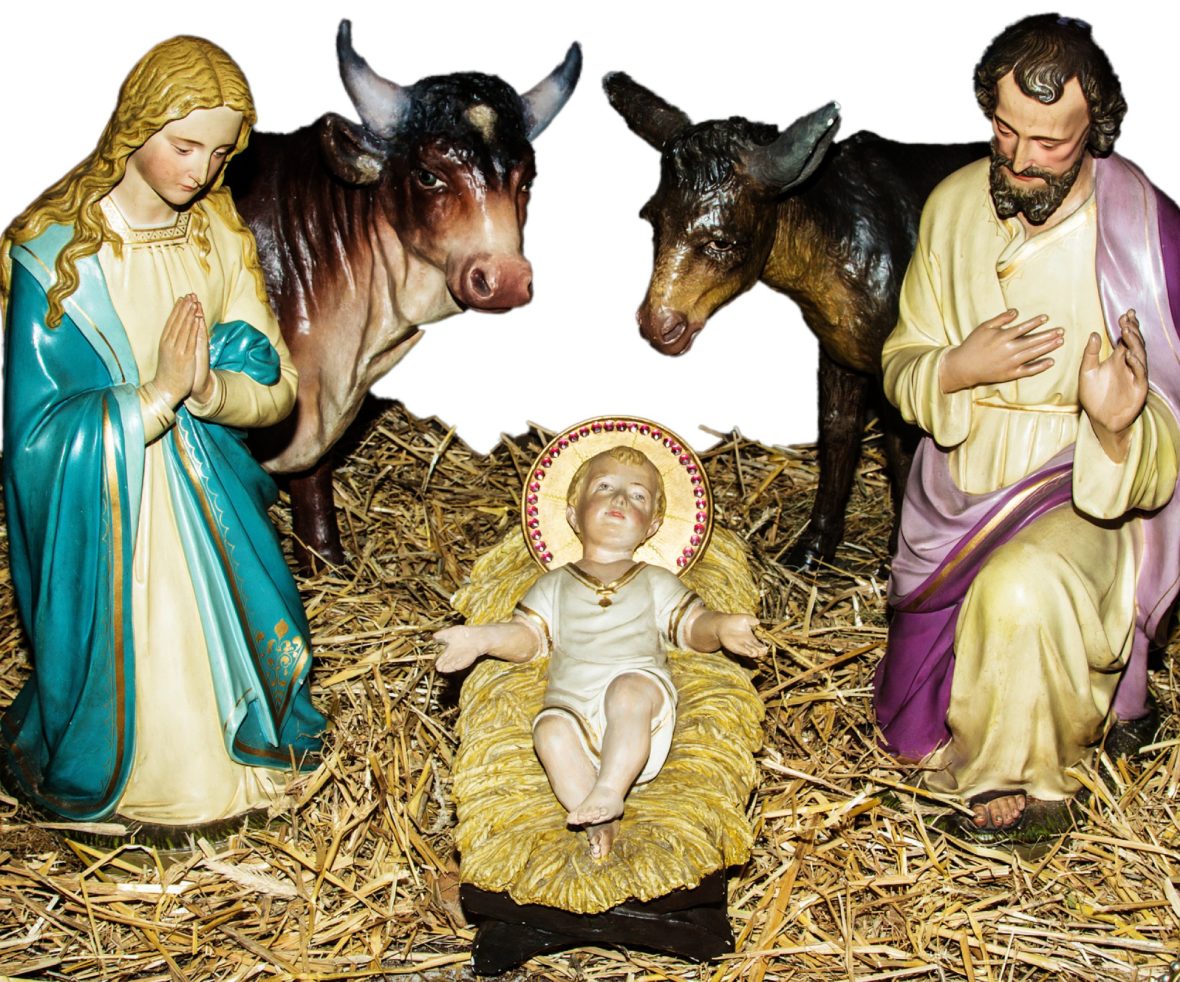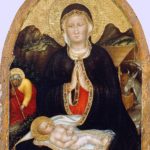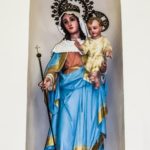As the Church continues its Octave of the Nativity, which is one long Christmas day, thoughts about the Infant King cross the mind. Catholic devotion to Jesus Christ in His babyhood is long and rich. It has shown itself in Nativity sets, and paintings, statues, prayer, song, and poetry. Fish Eaters report that:
Devotion to the Infant Jesus is another aspect of honoring Christ’s Incarnation. It is to marvel at His having humbled Himself by taking on a human nature, subjecting Himself to all that flesh is heir to (minus the effects of original sin, of course), even subjecting Himself to the earthly authority of Mary and Joseph. Recognized even in the Virgin’s womb by St. John the Baptist and his mother, after His Nativity, the Child Jesus was adored first by the shepherds and then by the Magi, and has been revered by Saints ever since. Many of the heroes and heroines of our Faith had a special devotion to the Child Jesus, some even having been blessed by visions of Him as a boy. St. Christopher, St. Anthony of Padua, St. Teresa of Avila, St. Rose of Lima, St. Thérèse of Lisieux (whose religious name is “St. Thérèse of the Child Jesus and the Holy Face”), St. Francis of Assisi with his creche, and, of course, Our Lady and St. Joseph, are particularly associated with the Divine Child and many are pictured with Jesus as a child in art…
In Prague, Czech Republic, there is a statue of the Christ Child known as the “Infant of Prague.” The statue is Spanish in origin, having ended up in its present country when it was taken there as a wedding gift given to a Spanish woman upon her marriage to a Czech nobleman. It passed down through that family, and was eventually given to the Disalced Carmelites there. In 1628, the Carmelites had to escape the area when the Saxons, and then the Swedes, attacked. Father Cyril a Matre Dei returned to Prague in 1638 and found the statue lying in what was left of the church, its arms broken. He placed it back in the oratory for veneration and, while praying near it one day, heard the voice of the Infant Jesus say to Him, “Have pity on Me and I will have pity on you. Give Me My hands and I will give you peace. The more you honor Me, the more I will bless you”. In that war-torn era, the priest didn’t have the money to carry out that wish, so prayed for guidance. He heard the Child Jesus again, “Place Me near the entrance of the sacristy and you will receive aid.” And so it happened. Within a few days, a rich man came by and offered to repair the statue. The statue became known for its association with the miraculous, including healings and, especially, for the protection of the church through so many wars that followed. Many benefits are said to come to those who worship Christ under His title of the “Infant of Prague.” There are prayers and novenas …to Him under this name.
The statue is around 18½ inches tall and made of wax, possibly with a wooden inner core. The Christ Child holds a globe surmounted by a Cross — symbolizing His Kingship. His right hand is raised in a blessing, his first two fingers extended to signify His two natures. The statue was not originally dressed…, but was first crowned by Bernard Ignatius in 1651, and was solemnly coronated by the Bishop of Prague in 1655. Now it is always seen not only crowned… but dressed in regal, priestly robes (the statue has over 85 different robes, including one sent by Empress Mary Theresa). Since 1788, sometimes two rings adorn the statue’s fingers, gifts from a noble family in gratitude for the cure of their daughter. The statue can be seen in the Church of St. Mary the Victorious and St. Anthony of Padua…Replicas can be bought at many different Catholic gift shops, and the image of the Infant of Prague is often represented two-dimensionally in paintings and on Holy Cards.
A famous copy of this icon can be seen on the Island of Cebu in the Philippines, and the story of its presence there is very interesting. The great Portugese explorer Ferdinand Magellan gave a copy of the statue of the Infant of Prague to Cebu’s king Rajah Humabon’s wife, after she converted and took the name Queen Juana upon her baptism in 1521. Magellan’s chaplain, Padre Pedro de Valderrama, converted many of the island’s natives — a move which led to a skirmish between the old and new Christians, and natives from the island of Mactan. The Christian Cebu side lost, Magellan was killed, and his crew later returned to Spain.
In 1565, the Spanish Captain, Miguel Lopez de Legazpi, went to Cebu accompanied by Augustinian Missionaries. They were attacked and, of course, defended themselves. Among the ruins of the battle’s aftermath, they found the statue of the Holy Infant (El Santo Niño) that Magellan had given to Queen Juana years earlier. A shrine was built to house the statue, and it later became the Basilica Minore del Santo Niño. The Holy Infant is especially dear to the Filippino people to this day, and in the first month of the year, there are in His honor great parades, celebrations, a Feast on the third Sunday of January, and even a special dance (sinulog). Devotion to the Holy Child, though, is year-round in the Philippines, and no Filippino home is without an image of El Santo Niño.
El Santo Niño de Atocha
In Mexico, the Holy Child is known under various titles, the most famous of which is El Santo Niño de Atocha. In the Mexican State of Zacatecas are two towns with two shrines: the more famous Fresnillo, home of the “Blue Santo Niño,” and Plateros, where the “Pink Santo Niño” is found. The statues of the Infant are dressed in the attire of a pilgrim: brimmed hat, cape, and a scallop shell — the pilgrim’s badge indicating pilgrimage to Compostela where the relics of St. James the Greater can be found. He carries a basket of food, and a pilgrim’s staff to which are fasted a gourd (to hold water) and wheat.
The devotion originated in Atocha, Spain when the Moors invaded and took many Christians as prisoners. The Christians were disallowed visitors and began to fear for their very lives as they lacked food and anyone to bring them some. After praying intensely for relief, the Christ Child appeared dressed in the attire described above and bearing a basket of food and a container of water, neither of which were depleted until they were no longer needed. El Santo Niño de Atocha is most often invoked for healing, especially of children. Pilgrims to his shrines leave children’s shoes, a custom born in the folk tale that the Child wears out His own as He goes about at night secretly visiting sick children in order to heal them.
Santo Bambino di Ara Coeli
The Church of Santa Maria di Ara Coeli on the Capitoline Hill in Rome is built on the ruins of ruins of a temple to Juno Moneta, on the steps of which the Roman Senate used to meet (and where, by the way, Roman coins used to be minted, hence our word “money”). According to legend, the earliest extant text of which derives from the late 4th century, Emperor Augustus, consulted the Tiburtine Sibyl — the sibyl who prophecied from the town of Tibur (the modern town of Tivoli) — after he learned he was to be honored as a god. The Sibyl prophesied that “the King of the Ages” would soon come, and as she did, the Emperor had a vision of the Virgin standing on an altar, surrounded by a bright halo and holding the Infant. A voice said: “This is the altar of the Son of God.” An altar to this future King was raised on the pagan site and became known as the “Altar of Heaven” (Ara Coeli). And of course, Our Lord was born during Augustus’s reign. In the 6th century, a church was built over the site. Over the ages, it was enlarged, first housing Byzantine monks, then the Benedictines, and then the Franciscans, who still tend the place today.
Inside this church is housed a statue of the Baby Jesus carved in the 15th century by a Franciscan friar in Jerusalem, from an olive wood tree that is said to have grown in the Garden of Gethsemani. It is said that the friar ran out of paint when he was making it, and so angels came and finished it while he slept. It is also said that when it was being transported from the Holy Land to Rome, it fell overboard when the ship that was carrying it was caught in a storm — only to wash up on the shores of Livorno, at the feet of the Franciscan who was awaiting its arrival. Down through the centuries, the statue became associated with many miraculous cures, and it was often carried to the bedsides of those who were sick or dying (this used to be effected by transporting the image in a golden carriage dedicated by the people of Rome just for this purpose; now a less ornate carriage is used). Letters and prayer requests are sent from all over the world to the church of Santa Maria di Ara Coeli to be placed near the statue as a sign of prayer. The statue is kept in the sacristy (a copy sits in a private chapel on the premises), but on Christmas Eve, it is brought out and unveiled at the sound of the Gloria, processed to a nativity scene, placed in Mary’s lap, and kept there until the Feast of the Epiphany (6 January). On that day, the statue is taken to the top of the staircase outside the church so that Romans might blow it kisses as the zampognari and pifferai (bagpipers and flautists) play, and then returned to its private chapel. Nowadays, all of these purposes are served by use of a second copy, as the original was stolen in February of 1994.
As noted above, the devotion to the Christ Child, the Infant King, is long and rich. This devotion is, also, commemorated in music, with the following as an example:
And, devotion to the Infant King is seen in poetry; and an example of this is seen in G.K. Chesterton’s poem titled The Christ-child Lay on Mary’s Lap:
The Christ-child lay on Mary’s lap,
His hair was like a light.
(O weary, weary were the world,
But here is all aright.)
The Christ-child lay on Mary’s breast,
His hair was like a star.
(O stern and cunning are the kings,
But here the true hearts are.)
The Christ-child lay on Mary’s heart,
His hair was like a fire.
(O weary, weary is the world,
But here the world’s desire.)
The Christ-child stood at Mary’s knee,
His hair was like a crown.
And all the flowers looked up at Him,
And all the stars looked down.
In the Christ Child is the world’s desire.
Beautiful!
May you continue to enjoy Christmas.
~SCF






